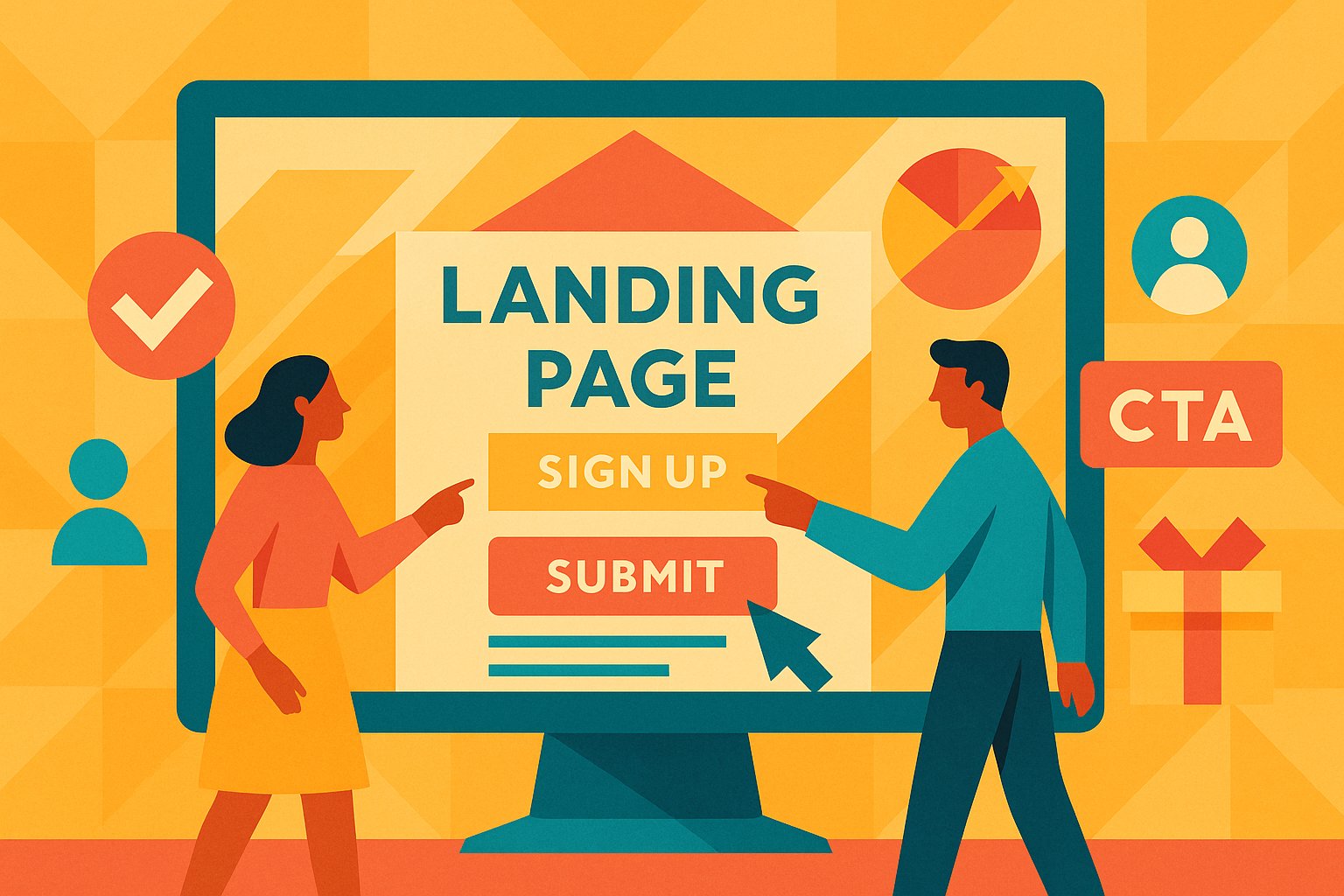Why Pre-Launch Analytics Matter: Setting the Stage for Success
Imagine hitting “publish” on your landing page and watching it immediately draw a stampede of eager visitors. Without the right data, however, you’re essentially flying blind—hoping that your headline resonates, your call-to-action compels, and your value proposition convinces. Landing page analytics before launch provide a safety net, letting you pivot or refine key elements before investing heavily in advertising or publicity. By understanding who arrives on your page, how they engage, and where they stumble, you can transform a “just okay” initial launch into a data-driven triumph. In a world where first impressions online are everything, pre-launch insight is the difference between potential customers clicking away or signing up en masse.
Decoding Visitor Behavior: Metrics That Reveal Intent
When a visitor lands on your pre-launch page, their digital footprint reveals more than mere eyeballs—it tells a story of interest, hesitation, or outright confusion. Tracking pageviews is a given, but digging into deeper metrics like bounce rate, average session duration, and scroll depth unlocks vital clues. A high bounce rate might indicate that your headline or above-the-fold content fails to align with audience expectations. Conversely, extended time on page could signal genuine curiosity, suggesting that your messaging or visuals resonate even if the conversion hasn’t happened yet. Scroll depth measures whether visitors make it past your key benefits or testimonials. If only 30 percent of visitors reach your signup form, perhaps your mid-page copy needs a refresh. Heatmaps and clickmaps go a step further—revealing exactly where eyes linger and where fingers tap. Identifying “dead zones” on the page, where no interaction occurs, can guide you to reposition crucial elements like social proof or trust badges. By harnessing these behavioral insights, you craft a landing page that aligns with visitor intent long before you press “go live.”
Traffic Origins: Understanding Where Your Audience Comes From
Not all traffic is created equal. A visitor clicking through from an industry blog often carries different intent compared to someone arriving via a paid advertisement or organic search. Pre-launch, it’s critical to tag your promotional links with unique UTM parameters so you can distinguish between channels—social media, email newsletters, influencer shout-outs, or organic search. When you see that a particular tweet drives 500 visitors with a 5 percent signup rate, yet an email blast commands only 100 visits with a 20 percent signup rate, you glean invaluable insights about channel efficiency. Perhaps your audience prefers direct, long-form email messaging over fleeting social posts. By cataloging and comparing traffic origins, you optimize marketing spend and prioritize channels that yield the most qualified leads. Moreover, keeping tabs on referral sites—forums, partner websites, or niche communities—allows you to tailor messaging for those audiences specifically, ensuring that your landing page copy and visuals resonate with each traffic source.
Engagement Hotspots: Tracking Key Interactions
A visitor doesn’t convert by simply staring at your page—they need to take action. Pre-launch analytics should spotlight every click, tap, and form submission. Are visitors clicking on your “Notify Me” button but abandoning the form halfway? That drop-off rate signifies an opportunity to simplify your fields or adjust your incentive. When a button click doesn’t result in a completed action, that’s a red flag: maybe your button color blends with the background, or your copy isn’t clear enough about what happens next. Consider implementing event tracking to measure interactions with interactive elements like video play buttons, downloadable resources, or countdown timers. If 80 percent of users play your teaser video but only 10 percent click the sign-up button afterward, you might rethink your video length or call-to-action overlay. Tracking engagement signals—how many users scroll to your testimonials, hover over feature sections, or interact with your chatbot—reveals the elements that excite prospects and the spots where interest wanes. By turning every click into a data point, you continually refine your landing page to guide visitors seamlessly toward conversion.
Early Experiments: A/B Testing Before the Spotlight
While it’s tempting to trust your instincts on headline phrasing or button color, pre-launch A/B testing transforms guesswork into evidence-based decisions. By splitting incoming traffic between two variations of a key element—say, a bold headline versus a benefit-driven subheading—you determine which resonates more deeply with your audience. Run these tests on small segments of traffic to minimize risk. Even a seemingly minor adjustment, such as changing “Join the Waitlist” to “Get Early Access,” can yield a significant lift in click-through rates. Beyond headlines, experiment with alternative layouts: one design with an image at the top, another with a hero video background. Track performance metrics like click-through rate, bounce rate, and conversion rate for each variation. If one version demonstrates a 15 percent higher sign-up rate, you know exactly what to deploy for maximum impact. A/B testing pre-launch ensures that when traffic spikes on launch day, you’re already offering the most compelling version of your page.
Performance Matters: Page Speed and Mobile Friendliness
Even the most beautifully crafted landing page will falter if it loads slowly or displays poorly on mobile devices. In today’s fast-paced digital world, users expect pages to load in two seconds or less. Tracking pre-launch performance metrics—page load time, server response time, and mobile rendering errors—prevents costly delays when your promotional campaigns roll out. Employ tools like Google PageSpeed Insights or Lighthouse to tally your performance score, identify render-blocking assets, and optimize images. A high-resolution hero image might look gorgeous on desktop, but if it drags your mobile load time to six seconds, you risk losing half of your visitors before they even see your headline. Monitor mobile responsiveness by testing across various devices and browsers to ensure that buttons remain clickable, fonts stay legible, and forms remain easy to complete. By prioritizing performance metrics before launch, you guarantee a seamless user experience that sets the stage for higher retention and conversion rates.
Segmenting Your Audience: New vs. Returning Visitors
Understanding how different visitor segments behave on your pre-launch page carries powerful implications for personalization and retargeting strategies. Tracking metrics for first-time visitors reveals initial impressions: how compelling is your page when someone sees it for the very first time? Are they immediately drawn to the core benefit, or do they need more context before engaging? By contrast, returning visitors indicate a deeper level of interest. Perhaps they’ve bookmarked your page, visited multiple times, or clicked on several blog posts leading up to the launch. Use cookies or tracking pixels to distinguish these segments and tailor subsequent messaging. A returning visitor might be better served by a pop-up offering an exclusive behind-the-scenes look, whereas a first-time visitor needs a concise intro and an irresistible value proposition. Pre-launch, analyze metrics like visit frequency, time between visits, and the path users take to return. When launch day arrives, this segmented data enables you to deploy targeted ads, email follow-ups, or personalized site messaging that speaks directly to each audience group’s stage in the buyer journey.
Gathering Qualitative Feedback: The Human Touch
While hard metrics tell you what happened, qualitative feedback unveils why it happened. Incorporating brief surveys or feedback widgets on your landing page before launch offers direct user perspectives that numbers alone cannot capture. Ask simple questions: “What would make this page more compelling?” or “Is anything unclear about our offer?” Avoid lengthy questionnaires; a single open-ended question can reveal pain points you never considered. Live chat and chatbot interactions also serve as rich sources of qualitative data. When visitors ask similar questions—“What’s the subscription cost?” or “When will the product ship?”—it highlights areas where your copy may need clarification. Monitor social media mentions or direct messages related to your pre-launch page to gauge organic feedback from users talking about your brand elsewhere. By blending qualitative insights with quantitative analytics, you develop a holistic view of user needs, allowing you to refine messaging, tweak design elements, and smooth out friction points ahead of launch day.
Goal Setting and Benchmarking: Defining Success Pre-Launch
Without clear objectives, analytics become an endless sea of data without direction. Pre-launch, define specific goals—email list sign-ups, waitlist registrations, social shares, or pre-order purchases—and set benchmarks for each. Establishing realistic targets, whether that’s a 10 percent conversion rate from all page traffic or 5,000 unique visitors in the first two weeks, ensures you can measure progress effectively. Tie these goals directly to your broader marketing plan. If your email list target is 2,000 subscribers before launch, calculate the required traffic volume and conversion rate needed to hit that mark. Use analytics to monitor progress daily or weekly, and adjust tactics if you fall short. If you measure a 2 percent conversion rate but need 5 percent to hit your subscriber goal, re-evaluate your headline, call-to-action placement, or incentive offer. By benchmarking pre-launch performance against concrete targets, you maintain a clear roadmap for optimization. When launch day arrives, you’ll not only know whether you’ve met your goals but also which levers drove success.
Integrating with Email and Ad Campaigns: Holistic Tracking
Pre-launch landing page analytics shouldn’t exist in a vacuum; they integrate seamlessly with broader email marketing and paid advertising strategies. Tag each email blast with distinct UTM parameters so you can trace exactly how many subscribers clicked through to your landing page and which email subject lines performed best. Similarly, if you’re running Facebook or Google Ads directed at your pre-launch page, track metrics like click-through rate, cost per click, and cost per acquisition (CPA). By consolidating data from your email platform, ad dashboard, and landing page analytics tool—be it Google Analytics, Mixpanel, or a dedicated landing page analytics service—you obtain a unified view of funnel performance. If your paid ads drive a flood of high-cost traffic with minimal conversions, you can pivot budget to organic channels or test new ad creatives. Conversely, if email-based traffic produces a higher conversion rate, consider expanding your email list through additional lead magnet offerings. Integrating these data streams transforms your pre-launch campaign into a coherent ecosystem where every channel informs the others.
Continuous Improvement Loop: Iterating Before the Big Day
The beauty of pre-launch analytics lies in its iterative nature. As you gather data, integrate feedback, and refine your page, you cycle through a feedback loop that continually optimizes user experience. Set up weekly review meetings with your team—designers, copywriters, marketers, and developers—to discuss insights gleaned from analytics. Celebrate wins, such as a drop in bounce rate or a spike in click-throughs, and identify areas that still need work. Roadmap your iterations: if your heatmap shows a critical section is being overlooked, rewrite the header or reposition it above the fold. If your mobile conversion lags behind desktop, simplify navigation and ensure form fields fit small screens comfortably. Track the impact of each change by comparing metrics before and after implementation. By committing to a process of continuous improvement, you avoid the trap of complacency and ensure your landing page evolves in lockstep with user expectations. When your launch day finally arrives, you’ll have a thoroughly tested, data-backed page poised to convert interest into action.
Conclusion: Your Pre-Launch Analytics Blueprint
Landing page analytics before launch are not an optional extra—they are the cornerstone of a successful debut. From decoding visitor behavior and tracking traffic sources to monitoring engagement signals and conducting A/B tests, each metric serves as a vital piece of puzzle in understanding how your audience perceives and interacts with your brand. By integrating performance data with qualitative feedback, setting clear benchmarks, and iterating rapidly, you craft a landing page that not only attracts attention but also converts interest into concrete leads. When you finally unveil your product or service to the world, you’ll do so armed with the confidence that comes from knowing your page has been optimized, tested, and refined to resonate with your target audience. In a digital marketplace driven by first impressions, pre-launch landing page analytics ensure that those impressions translate into measurable success.




